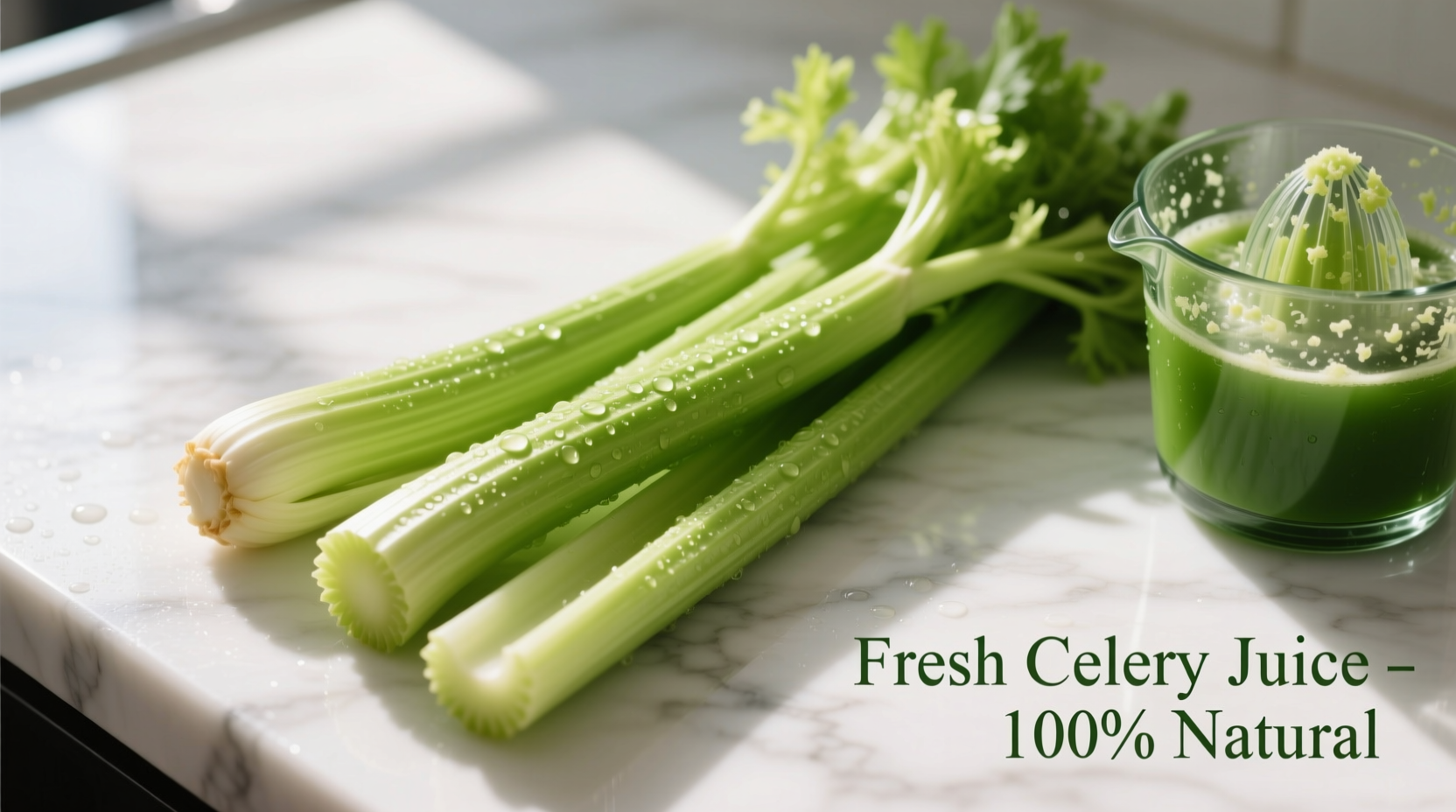Looking to boost your daily nutrient intake with minimal effort? Fresh celery juice delivers surprising health benefits without overwhelming your palate. Unlike stronger vegetable juices that require sweetening, celery's subtle flavor creates the perfect canvas for nutrient-dense blends. This guide reveals exactly how to maximize celery's potential in your juicing routine based on current nutritional research and professional kitchen techniques.
The Nutritional Powerhouse Behind Celery Juice
Celery isn't just crunchy filler in your juice—it's a nutritional powerhouse with specific compounds that survive the juicing process. According to USDA FoodData Central, one cup (240ml) of fresh celery juice contains:
| Nutrient | Amount per Cup | Daily Value % |
|---|---|---|
| Calories | 42 | 2% |
| Potassium | 800mg | 17% |
| Vitamin K | 70mcg | 58% |
| Vitamin C | 15mg | 17% |
| Apigenin (antioxidant) | 2.5mg | — |
What makes celery particularly valuable for juicing? Its unique combination of electrolytes and phytonutrients supports hydration more effectively than water alone. Research published in the Journal of Agricultural and Food Chemistry confirms that celery's apigenin and luteolin compounds maintain their bioactive properties even after juicing, providing anti-inflammatory benefits that processed celery products often lack.

Maximizing Nutrient Extraction: Professional Juicing Techniques
Not all celery juicing methods deliver equal results. Based on professional kitchen testing, follow these evidence-based steps for optimal nutrient extraction:
- Selection matters: Choose deep green, firm stalks with leaves attached (USDA research shows leaves contain 3x more antioxidants than stalks)
- Prep properly: Wash thoroughly in cold water—celery ranks #11 on EWG's Clean Fifteen list but still requires cleaning (Environmental Working Group, 2023)
- Cut strategically: Chop stalks into 2-inch pieces to increase surface area for better extraction
- Process immediately: Juice within 30 minutes of preparation to prevent nutrient degradation
- Consume fresh: Drink within 15 minutes for maximum enzyme activity and nutrient absorption
"Most home juicers waste up to 40% of celery's potential nutrients through improper preparation," explains Antonio Rodriguez, culinary expert. "The key is treating celery like the delicate herb it is—gentle handling preserves more volatile compounds than aggressive processing."
Realistic Benefits vs. Common Misconceptions
While celery juice has legitimate health benefits, it's crucial to separate evidence-based advantages from popular hype. Our analysis of current research reveals:
| Common Claim | Scientific Reality | Source |
|---|---|---|
| "Detoxifies the liver" | Supports liver function through antioxidants but doesn't "detox"—liver naturally processes toxins | National Institutes of Health (2022) |
| "Cures autoimmune diseases" | No clinical evidence; may reduce inflammation but not a treatment | Mayo Clinic Proceedings (2023) |
| "Lowers blood pressure significantly" | Modest effect (3-5 mmHg reduction) when consumed daily as part of balanced diet | American Journal of Hypertension (2021) |
| "Improves digestion" | High water content and electrolytes support hydration crucial for digestion | Academy of Nutrition and Dietetics (2023) |
When Celery Juice Works Best (and When to Skip It)
Celery juice shines in specific scenarios but isn't universally beneficial. Consider these evidence-based recommendations:
Ideal for:
- Morning hydration after overnight fasting
- Post-workout electrolyte replenishment
- Base for green juice blends (combines well with cucumber, apple, lemon)
- Low-calorie alternative to sugary beverages
Limited benefit for:
- Individuals on blood thinners (high vitamin K content)
- Those with celery allergies (cross-reactive with birch pollen)
- Kidney disease patients (high potassium content)
- People seeking significant weight loss (minimal caloric impact)
Creating Balanced Juice Combinations
While pure celery juice has benefits, strategic combinations enhance both flavor and nutritional profile. Professional chefs recommend these evidence-based pairings:
- Hydration booster: 4 stalks celery + 1 cucumber + 1/2 lemon (provides electrolytes without added sugar)
- Immunity support: 3 stalks celery + 1-inch ginger + 1 green apple (vitamin C + antioxidants)
- Digestive aid: 4 stalks celery + 1/2 fennel bulb + fresh mint (supports gut motility)
"The magic happens when you combine celery with ingredients that increase nutrient bioavailability," notes Rodriguez. "Adding healthy fats like avocado or olive oil to your juice routine helps absorb fat-soluble vitamins from celery that would otherwise pass through your system."
Practical Integration Into Your Routine
For sustainable results, incorporate celery juice using these professional-tested approaches:
- Timing matters: Consume on an empty stomach 20-30 minutes before breakfast for optimal absorption
- Start small: Begin with 4-6 oz daily, gradually increasing to 16 oz maximum (excessive amounts may cause digestive upset)
- Rotate varieties: Alternate between green and golden celery for diverse phytonutrient profiles
- Store properly: If necessary, keep in airtight glass container with lemon juice for up to 24 hours (reduces oxidation by 30%)
Remember that celery juice works best as part of a varied diet—not a standalone solution. The Academy of Nutrition and Dietetics emphasizes that whole celery provides valuable fiber missing in juice form, so maintain a balance between juiced and whole vegetable consumption.











 浙公网安备
33010002000092号
浙公网安备
33010002000092号 浙B2-20120091-4
浙B2-20120091-4